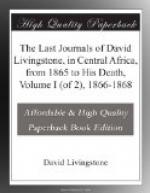21st September, 1866.—We marched westwards, making across the base of Cape Maclear. Two men employed as guides and carriers, went along grumbling that their dignity was so outraged by working—“only fancy Waiyau carrying like slaves!!” They went but a short distance, and took advantage of my being in front to lay down the loads, one of which consisted of the havildar’s bed and cooking things; here they opened the other bundle and paid themselves—the gallant havildar sitting and looking on. He has never been of the smallest use, and lately has pretended to mysterious pains in his feet; no swelling or other symptom accompanied this complaint. On coming to Pima’s village he ate a whole fowl and some fish for supper, slept soundly till daybreak, then on awaking commenced a furious groaning—“feet were so bad.” I told him that people usually moaned when insensible, but he had kept quiet till he awaked; he sulked at this, and remained all day, though I sent a man to carry his kit for him, and when he came up he had changed the seat of his complaint from his feet to any part of his abdomen. He gave off his gun-belt and pouch to the carrier. This was a blind to me, for I examined and found that he had already been stealing and selling his ammunition: this is all preparatory to returning to the coast with some slave-trader. Nothing can exceed the ease and grace with which sepoys can glide from a swagger into the most abject begging of food from the villagers. He has remained behind.
22nd September, 1866.—The hills we crossed were about 700 feet above Nyassa, generally covered with trees; no people were seen. We slept by the brook Sikoche. Rocks of hardened sandstone rested on mica schist, which had an efflorescence of alum on it, above this was dolomite; the hills often capped with it and oak-spar, giving a snowy appearance. We had a Waiyau party with us—six handsomely-attired women carried huge pots of beer for their husbands, who very liberally invited us to partake. After seven hours’ hard travelling we came to the village, where we spend Sunday by the torrent Usangazi, and near a remarkable mountain, Namasi. The chief, a one-eyed man, was rather coy—coming incognito to visit us; and, as I suspected that he was present, I asked if the chief were an old woman, afraid to look at and welcome a stranger? All burst into a laugh, and looked at him, when he felt forced to join in it, and asked what sort of food we liked best. Chuma put this clear enough by saying, “He eats everything eaten by the Waiyau.” This tribe, or rather the Machinga, now supersede the Manganja. We passed one village of the latter near this, a sad, tumble-down affair, while the Waiyau villages are very neat, with handsome straw or reed fences all around their huts.




